Insight on Poleward Moisture and Energy Transport into the Arctic from ERA5
Abstract
:1. Introduction
2. Materials and Methods
2.1. Data
2.1.1. Large-Scale Atmospheric Index
2.1.2. Sea Ice Concentration
2.1.3. ERA5 Reanalysis Dataset
2.2. Methods
2.2.1. Moisture and Energy Flux into the Arctic
2.2.2. Composite Analysis
2.2.3. Trend Maps
3. Spatiotemporal Characteristics of Moisture and Total Energy Transport into the Arctic
3.1. Spatial Distribution
3.2. Seasonal Variations
3.3. Long-Term Trends
4. Spatial Patterns in Poleward Moisture and Energy Transport Associated with Varying Large-Scale Atmospheric Circulation
5. Influence of Transport of Moisture and Energy on Sea Ice
6. Conclusions
Author Contributions
Funding
Acknowledgments
Conflicts of Interest
References
- Kim, K.-Y.; Hamlington, B.D.; Na, H.; Kim, J. Mechanism of seasonal Arctic sea ice evolution and Arctic amplification. Cryosphere 2016, 10, 2191–2202. [Google Scholar] [CrossRef] [Green Version]
- Serreze, M.C.; Barrett, A.P.; Stroeve, J.C.; Kindig, D.N.; Holland, M.M. The emergence of surface-based Arctic amplification. Cryosphere 2009, 3, 11–19. [Google Scholar] [CrossRef] [Green Version]
- Screen, J.A.; Simmonds, I. The central role of diminishing sea ice in recent Arctic temperature amplification. Nature 2010, 464, 1334–1337. [Google Scholar] [CrossRef] [PubMed] [Green Version]
- Serreze, M.C.; Barry, R.G. Processes and impacts of Arctic amplification: A research synthesis. Glob. Planet. Change 2011, 77, 85–96. [Google Scholar] [CrossRef]
- Ballinger, T.; Overland, J.; Wang, M.; Bhatt, U.; Hanna, E.; Hanssen-Bauer, I.; Kim, S.; Thomas, R.; Richter-Menge, J.; Drukenmiller, M. Surface air temperature. In Arctic Report Card; National Oceanic and Atmospheric Administration: Washington, DC, USA, 2021. [Google Scholar]
- Comiso, J.C.; Parkinson, C.L.; Gersten, R.; Stock, L. Accelerated decline in the Arctic Sea ice cover. Geophys. Res. Lett. 2008, 35, L01703. [Google Scholar] [CrossRef] [Green Version]
- Parkinson, C.L.; Comiso, J.C. On the 2012 record low Arctic sea ice cover: Combined impact of preconditioning and an August storm. Geophys. Res. Lett. 2013, 40, 1356–1361. [Google Scholar] [CrossRef]
- Cheng, B.; Zhang, Z.; Vihma, T.; Johansson, M.; Bian, L.; Li, Z.; Wu, H. Model experiments on snow and ice thermodynamics in the Arctic Ocean with CHINARE 2003 data. J. Geophys. Res. Ocean. 2008, 113, C090020. [Google Scholar] [CrossRef] [Green Version]
- Vihma, T.; Screen, J.; Tjernström, M.; Newton, B.; Zhang, X.; Popova, V.; Deser, C.; Holland, M.; Prowse, T. The atmospheric role in the Arctic water cycle: A review on processes, past and future changes, and their impacts. J. Geophys. Res. Biogeosci. 2016, 121, 586–620. [Google Scholar] [CrossRef] [Green Version]
- Gong, T.; Feldstein, S.; Lee, S. The Role of Downward Infrared Radiation in the Recent Arctic Winter Warming Trend. J. Clim. 2017, 30, 4937–4949. [Google Scholar] [CrossRef]
- Chang, L.; Gao, G.; Li, Y.; Zhang, Y.; Zhang, C.; Zhang, Y.; Feng, G. Variations in Water Vapor From AIRS and MODIS in Response to Arctic Sea Ice Change in December 2002–November 2016. IEEE Trans. Geosci. Remote Sens. 2019, 57, 7395–7405. [Google Scholar] [CrossRef]
- Johansson, E.; Devasthale, A.; Tjernström, M.; Ekman, A.M.; L’Ecuyer, T. Response of the lower troposphere to moisture intrusions into the Arctic. Geophys. Res. Lett. 2017, 44, 2527–2536. [Google Scholar] [CrossRef]
- Boisvert, L.N.; Petty, A.A.; Stroeve, J.C. The Impact of the Extreme Winter 2015/16 Arctic Cyclone on the Barents–Kara Seas. Mon. Weather Rev. 2016, 144, 4279–4287. [Google Scholar] [CrossRef]
- Graversen, R.G.; Mauritsen, T.; Tjernström, M.; Källén, E.; Svensson, G. Vertical structure of recent Arctic warming. Nature 2008, 451, 53–56. [Google Scholar] [CrossRef] [PubMed]
- Graversen, R.G.; Burtu, M. Arctic amplification enhanced by latent energy transport of atmospheric planetary waves. Q. J. R. Meteorol. Soc. 2016, 142, 2046–2054. [Google Scholar] [CrossRef]
- Graversen, R.G.; Mauritsen, T.; Drijfhout, S.; Tjernstrom, M.; Martensson, S. Warm winds from the Pacific caused extensive Arctic sea-ice melt in summer 2007. Clim. Dyn. 2011, 36, 2103–2112. [Google Scholar] [CrossRef]
- Dufour, A.; Zolina, O.; Gulev, S.K. Atmospheric moisture transport to the Arctic: Assessment of reanalyses and analysis of transport components. J. Clim. 2016, 29, 5061–5081. [Google Scholar] [CrossRef]
- Jakobson, E.; Vihma, T. Atmospheric moisture budget in the Arctic based on the ERA—40 reanalysis. Int. J. Climatol. 2010, 30, 2175–2194. [Google Scholar] [CrossRef]
- Villamil-Otero, G.A.; Zhang, J.; He, J.; Zhang, X. Role of extratropical cyclones in the recently observed increase in poleward moisture transport into the Arctic Ocean. Adv. Atmos. Sci. 2018, 35, 85–94. [Google Scholar] [CrossRef]
- Alekseev, G.; Kuzmina, S.; Bobylev, L.; Urazgildeeva, A.; Gnatiuk, N. Impact of atmospheric heat and moisture transport on the Arctic warming. Int. J. Climatol. 2019, 39, 3582–3592. [Google Scholar] [CrossRef] [Green Version]
- Thompson, D.W.J.; Wallace, J.M. The Arctic Oscillation Signature in the Wintertime Geopotential Height and Temperature Fields. Geophys. Res. Lett. 1998, 25, 1297–1300. [Google Scholar] [CrossRef] [Green Version]
- Wu, B.; Wang, J.; Walsh, J.E. Dipole anomaly in the Arctic atmosphere and winter Arctic sea ice motion. J. Clim. 2005, 19, 1529–1536. [Google Scholar] [CrossRef]
- Comiso, J.C. Bootstrap Sea Ice Concentrations from Nimbus-7 SMMR and DMSP SSM/I-SSMIS, Version 3; National Snow and Ice Data Center: Boulder, CO, USA, 2017. [Google Scholar]
- Zhang, X.; Walsh, J.E.; Zhang, J.; Bhatt, U.S.; Ikeda, M. Climatology and interannual variability of arctic cyclone activity: 1948–2002. J. Clim. 2004, 17, 2300–2317. [Google Scholar] [CrossRef]
- Hersbach, H.; Bell, B.; Berrisford, P.; Biavati, G.; Horányi, A.; Muñoz Sabater, J.; Nicolas, J.; Peubey, C.; Radu, R.; Rozum, I.; et al. ERA5 Hourly Data on Single Levels from 1979 to Present. Available online: https://cds.climate.copernicus.eu/cdsapp#!/dataset/reanalysis-era5-single-levels?tab=overview (accessed on 29 March 2022).
- Luo, B.; Luo, D.; Wu, L.; Zhong, L.; Simmonds, I. Atmospheric circulation patterns which promote winter Arctic sea ice decline. Environ. Res. Lett. 2017, 12, 054017. [Google Scholar] [CrossRef]
- Liu, J.; Curry, J.A.; Wang, H.; Song, M.; Horton, R.M. Impact of declining Arctic sea ice on winter snowfall. Proc. Natl. Acad. Sci. USA 2012, 109, 4074–4079. [Google Scholar] [CrossRef] [PubMed] [Green Version]
- Woods, C.; Caballero, R.; Svensson, G. Large-scale circulation associated with moisture intrusions into the Arctic during winter. Geophys. Res. Lett. 2013, 40, 4717–4721. [Google Scholar] [CrossRef]
- Gimeno, L.; Vázquez, M.; Nieto, R.; Trigo, R.M. Atmospheric moisture transport: The bridge between ocean evaporation and Arctic ice melting. Earth Syst. Dyn. 2015, 6, 583–589. [Google Scholar] [CrossRef] [Green Version]
- Serreze, M.C.; Kahl, J.D.; Schnell, R.C. Low-Level Temperature Inversions of the Eurasian Arctic and Comparisons with Soviet Drifting Station Data. J. Clim. 1992, 5, 615–630. [Google Scholar] [CrossRef]
- Naakka, T.; Nygård, T.; Vihma, T.; Sedlar, J.; Graversen, R. Atmospheric moisture transport between mid-latitudes and the Arctic: Regional, seasonal and vertical distributions. Int. J. Climatol. 2019, 39, 2862–2879. [Google Scholar] [CrossRef]
- Liang, Y.; Bi, H.; Wang, Y.; Huang, H.; Zhang, Z.; Huang, J.; Liu, Y. Role of Extratropical Wintertime Cyclones in Regulating the Variations of Baffin Bay Sea Ice Export. J. Geophys. Res. Atmos. 2021, 126, e2020JD033616. [Google Scholar] [CrossRef]
- Kim, B.-M.; Hong, J.-Y.; Jun, S.-Y.; Zhang, X.; Kwon, H.; Kim, S.-J.; Kim, J.-H.; Kim, S.-W.; Kim, H.-K. Major cause of unprecedented Arctic warming in January 2016: Critical role of an Atlantic windstorm. Sci. Rep. 2017, 7, 40051. [Google Scholar] [CrossRef]
- Gimeno, L.; Vázquez, M.; Eiras-Barca, J.; Sorí, R.; Nieto, R. Atmospheric moisture transport and the decline in Arctic Sea ice. Wiley Interdiscip. Rev. Clim. Change 2019, 10, e588. [Google Scholar] [CrossRef]
- Zahn, M.; Akperov, M.; Rinke, A.; Feser, F.; Mokhov, I.I. Trends of Cyclone Characteristics in the Arctic and Their Patterns From Different Reanalysis Data. J. Geophys. Res. Atmos. 2018, 123, 2737–2751. [Google Scholar] [CrossRef]
- Kapsch, M.-L.; Graversen, R.G.; Tjernström, M. Springtime atmospheric energy transport and the control of Arctic summer sea-ice extent. Nat. Clim. Change 2013, 3, 744–748. [Google Scholar] [CrossRef]
- Ding, Q.; Schweiger, A.; L’Heureux, M.; Battisti, D.S.; Po-Chedley, S.; Johnson, N.C.; Blanchard-Wrigglesworth, E.; Harnos, K.; Zhang, Q.; Eastman, R. Influence of high-latitude atmospheric circulation changes on summertime Arctic sea ice. Nat. Clim. Change 2017, 7, 289–295. [Google Scholar] [CrossRef]
- Olonscheck, D.; Mauritsen, T.; Notz, D. Arctic sea-ice variability is primarily driven by atmospheric temperature fluctuations. Nat. Geosci. 2019, 12, 430. [Google Scholar] [CrossRef]
- Graversen, R.G.; Langen, P.L. On the Role of the Atmospheric Energy Transport in 2× CO2–Induced Polar Amplification in CESM1. J. Clim. 2019, 32, 3941–3956. [Google Scholar] [CrossRef]
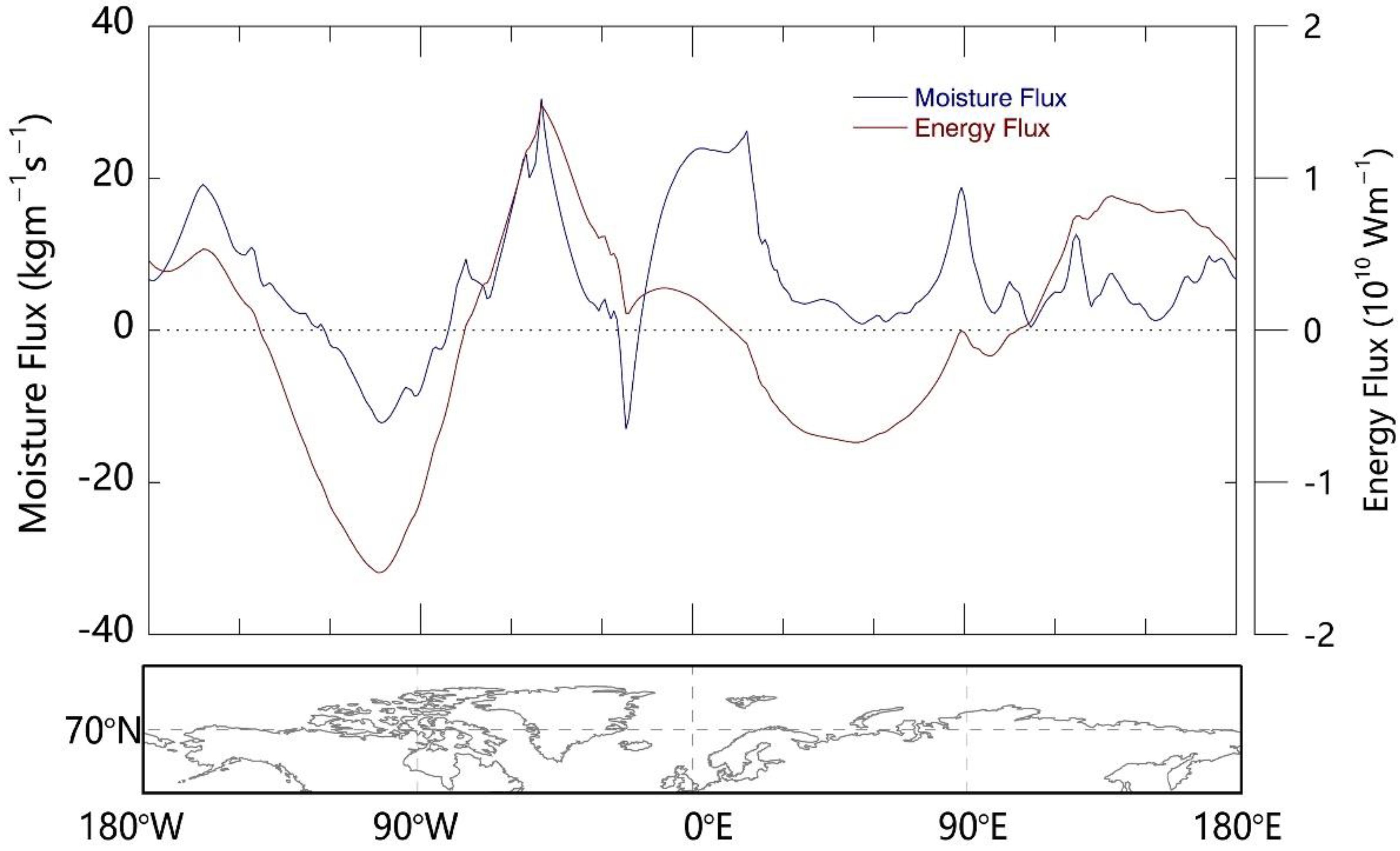

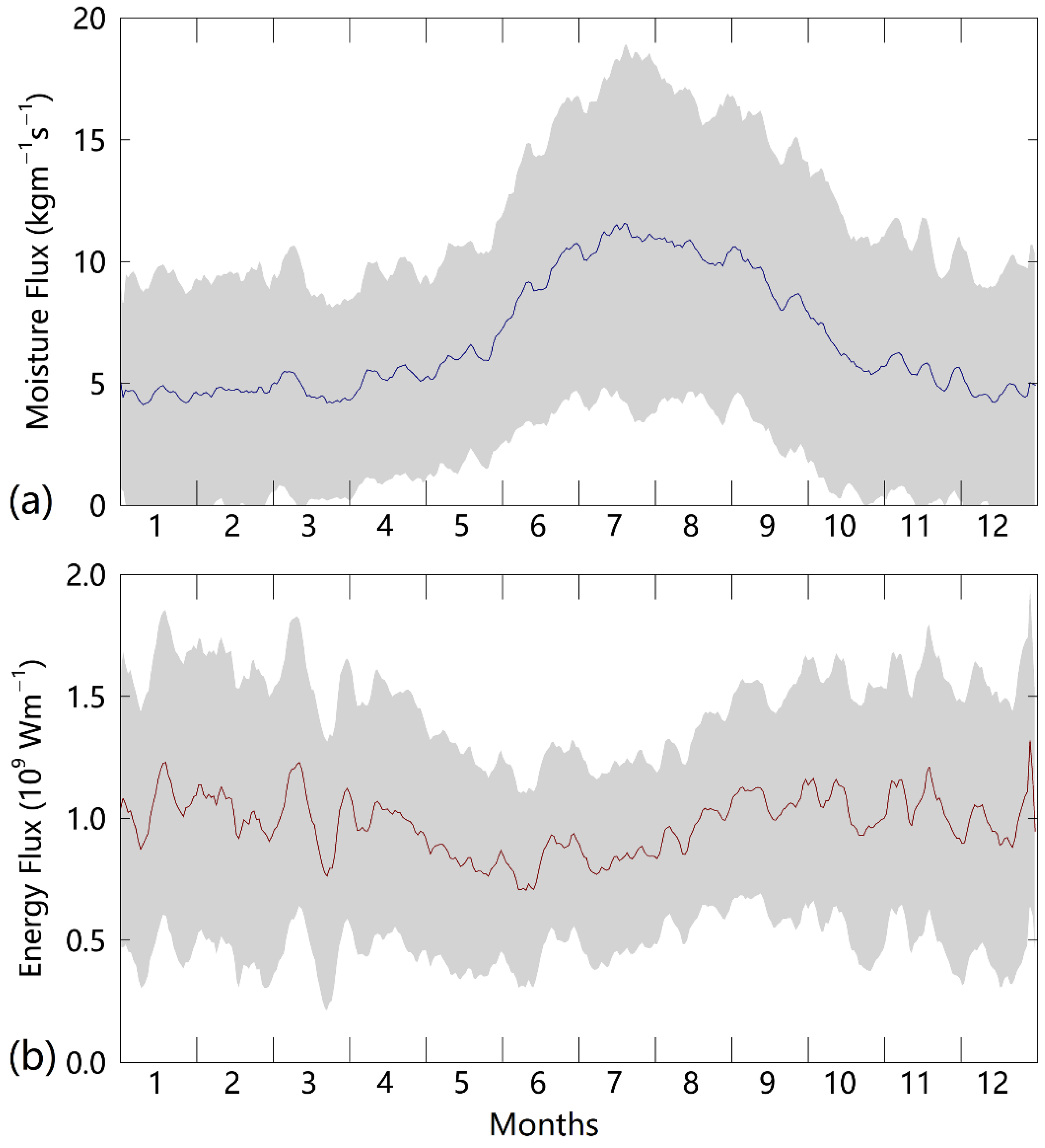
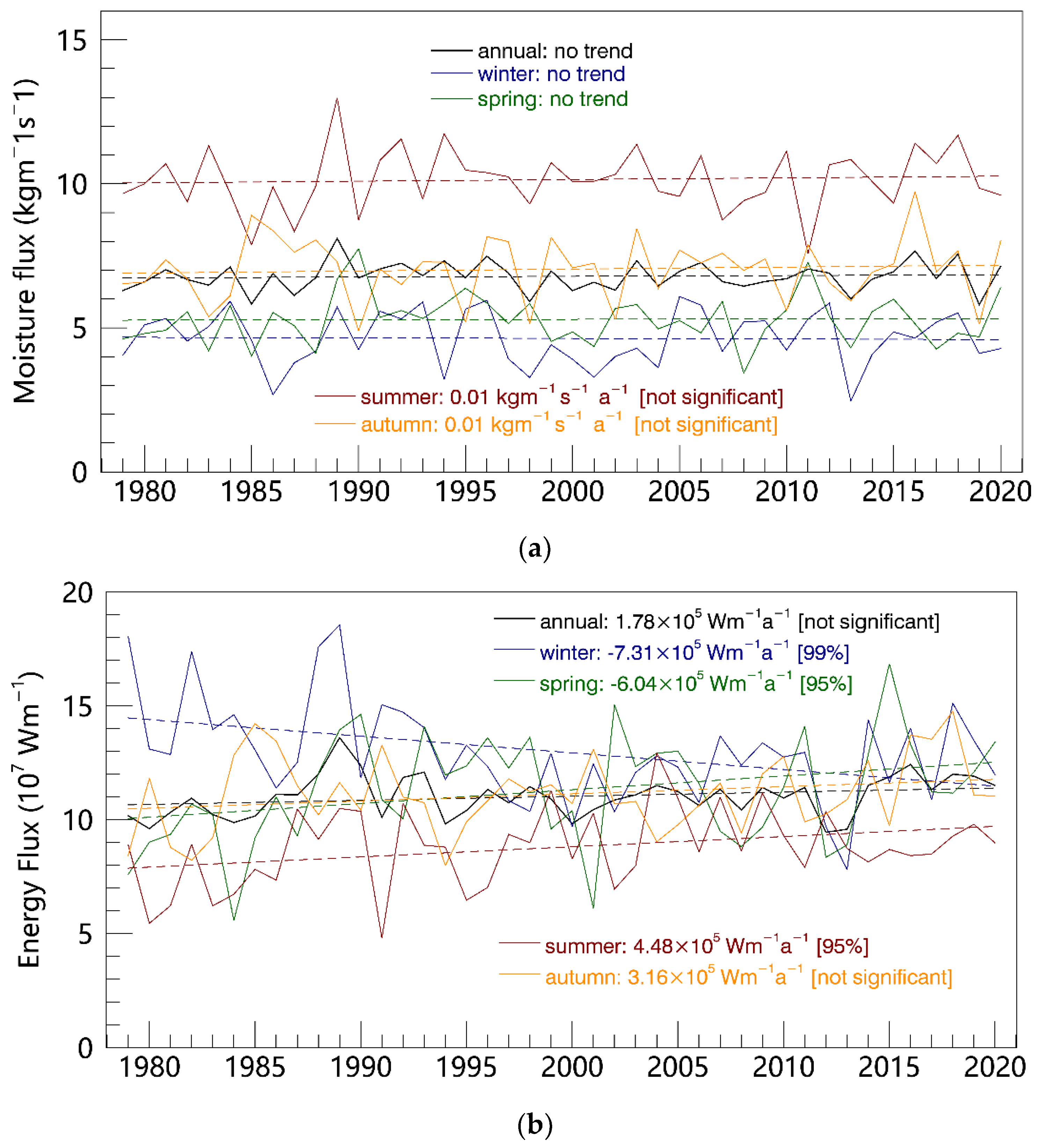
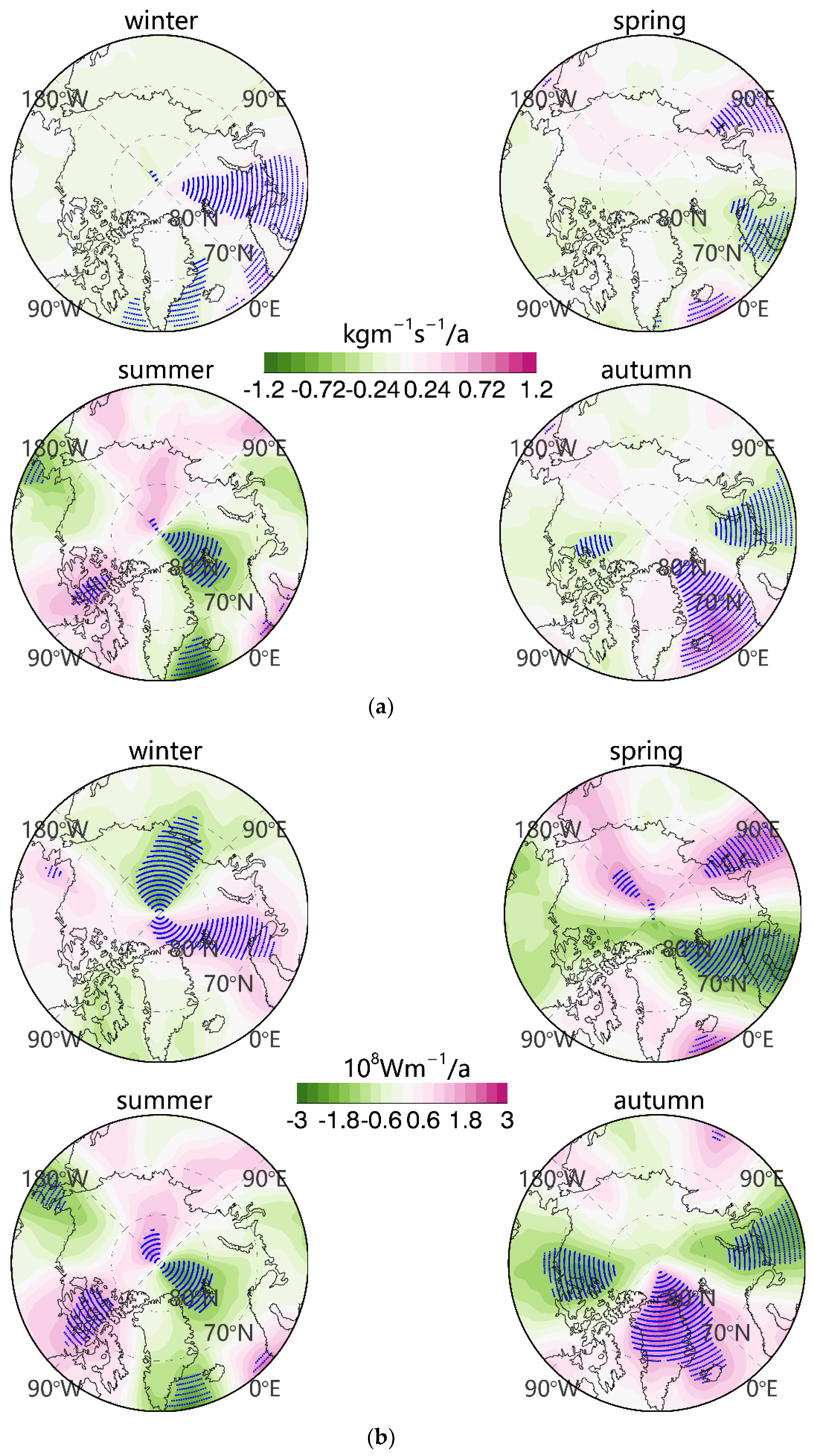
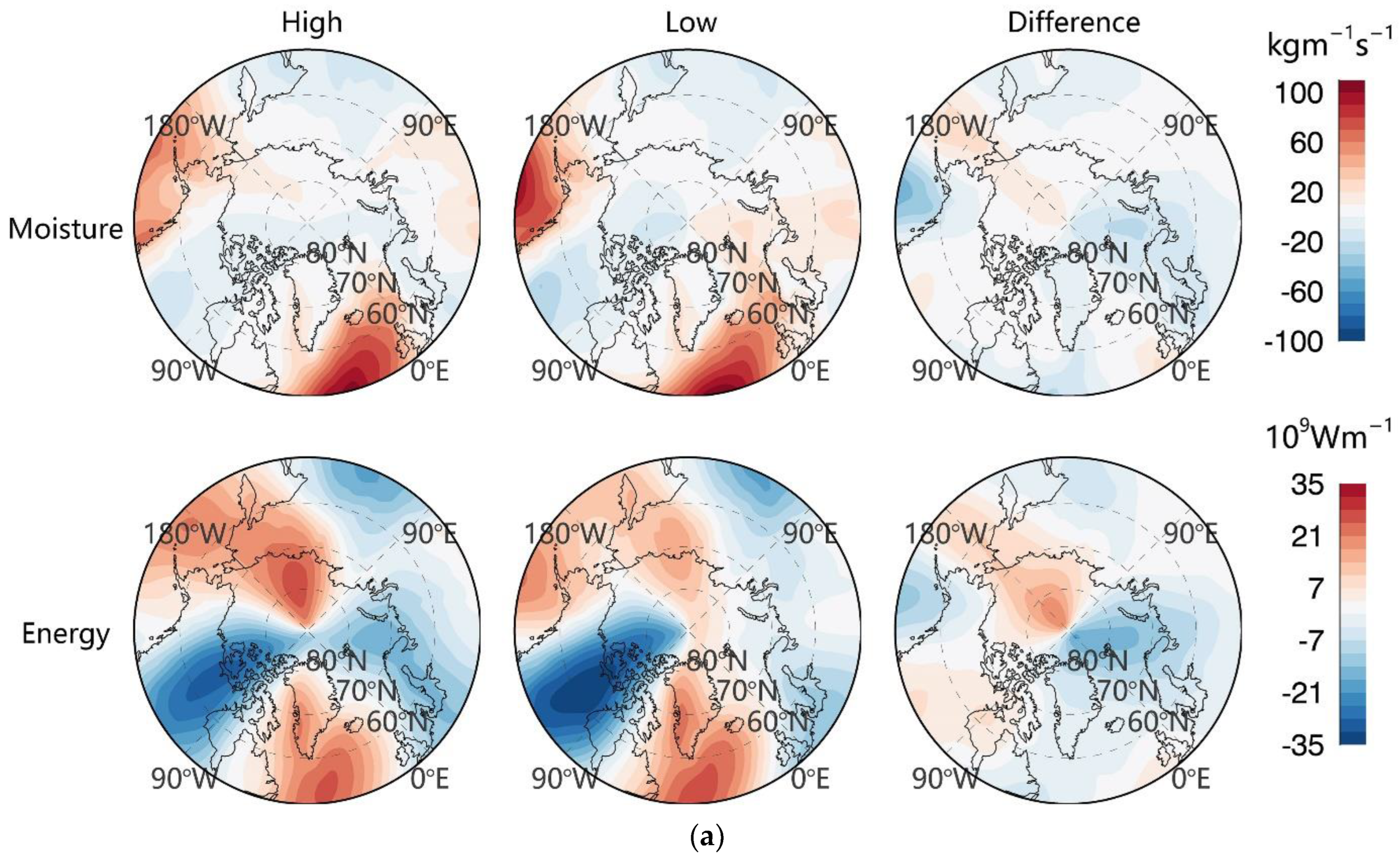
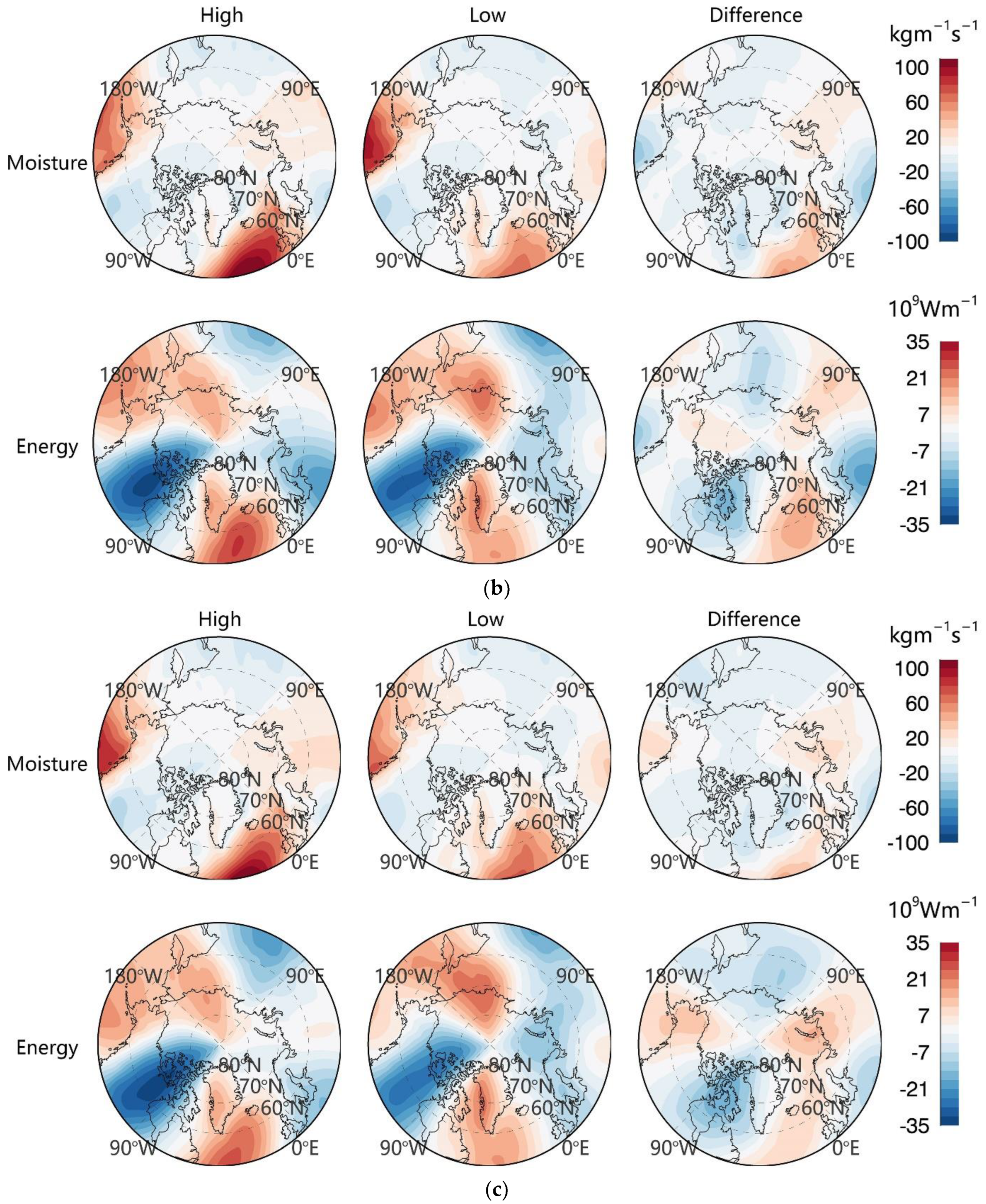

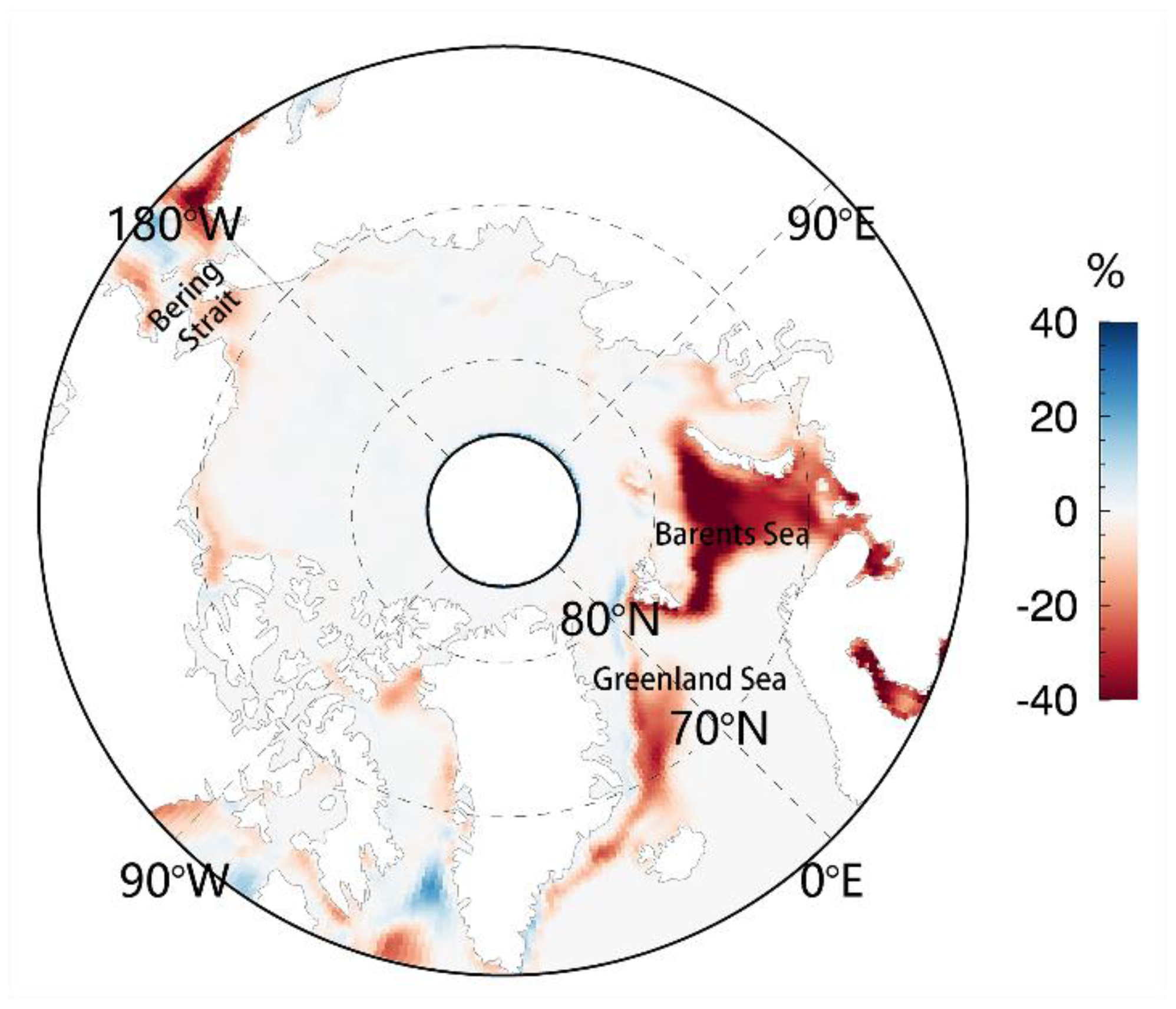
Publisher’s Note: MDPI stays neutral with regard to jurisdictional claims in published maps and institutional affiliations. |
© 2022 by the authors. Licensee MDPI, Basel, Switzerland. This article is an open access article distributed under the terms and conditions of the Creative Commons Attribution (CC BY) license (https://creativecommons.org/licenses/by/4.0/).
Share and Cite
Sun, W.; Liang, Y.; Bi, H.; Zhao, Y.; Meng, J.; Zhang, J. Insight on Poleward Moisture and Energy Transport into the Arctic from ERA5. Atmosphere 2022, 13, 616. https://doi.org/10.3390/atmos13040616
Sun W, Liang Y, Bi H, Zhao Y, Meng J, Zhang J. Insight on Poleward Moisture and Energy Transport into the Arctic from ERA5. Atmosphere. 2022; 13(4):616. https://doi.org/10.3390/atmos13040616
Chicago/Turabian StyleSun, Weifu, Yu Liang, Haibo Bi, Yujia Zhao, Junmin Meng, and Jie Zhang. 2022. "Insight on Poleward Moisture and Energy Transport into the Arctic from ERA5" Atmosphere 13, no. 4: 616. https://doi.org/10.3390/atmos13040616
APA StyleSun, W., Liang, Y., Bi, H., Zhao, Y., Meng, J., & Zhang, J. (2022). Insight on Poleward Moisture and Energy Transport into the Arctic from ERA5. Atmosphere, 13(4), 616. https://doi.org/10.3390/atmos13040616






